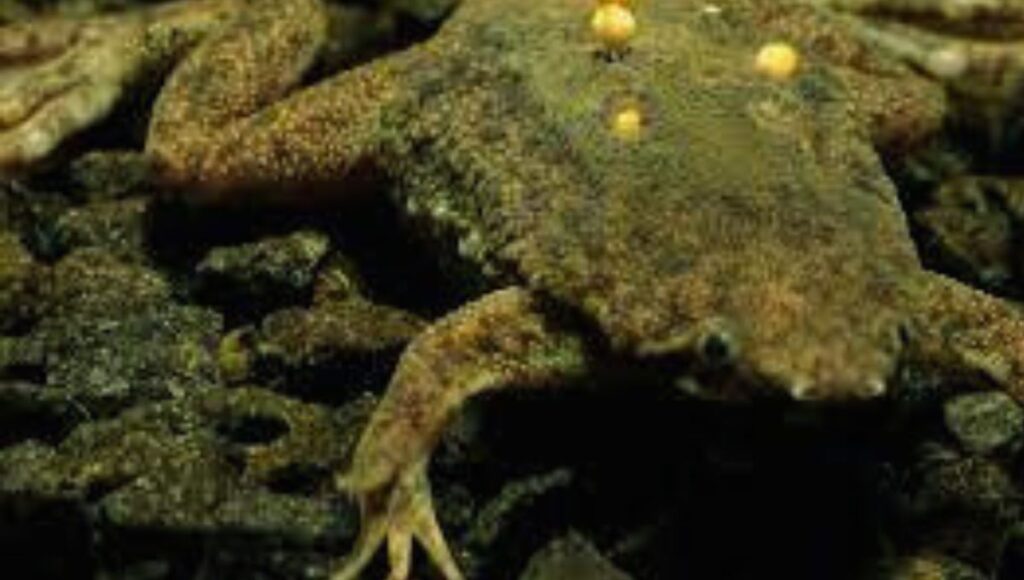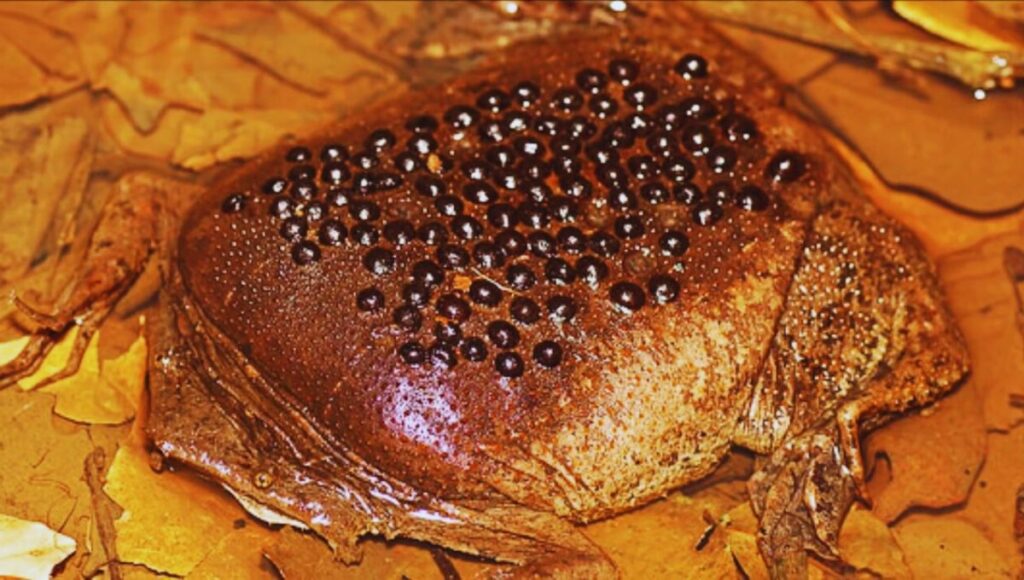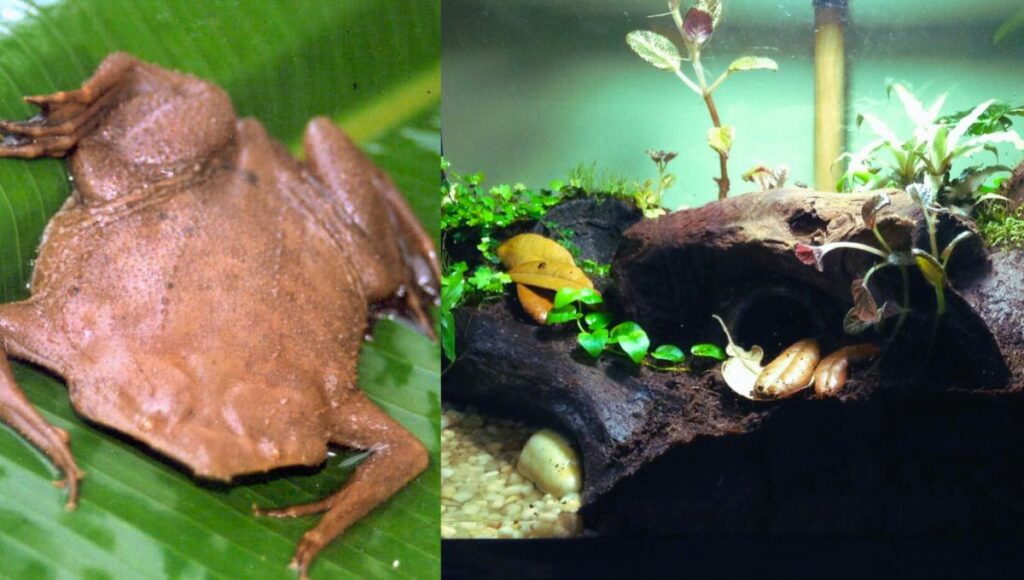The common Surinam toad, also known as the Star-fingered toad is known for its attractive hunting technique and egg incubation in honeycombed chambers on the mother’s back. But are the star-fingered Common Surinam toads good pets? Let’s dive into the reality.

Table of Contents
Everything About Common Surinam Toads:
In a Glimpse:
| Common Name | Common Surinam Toad |
| Scientific Name | Pipa pipa |
| Other Names | Star-fingered toad |
| Maximum Length | 6.7 inches |
| Maximum Weight | N/A |
| Ranges | South America |
| Habitat | Warm and moist wetlands |
| Diet | Omnivore |
| IUCN Status | Least Concern |
| Lifespan | 4-5 years |
Geographical Range:
Common Surinam toads are endemic to South America, more specifically to the Amazon Rainforest. 90% of their population is found in Brazil and Ecuador. The rest of the population is found in Bolivia, Colombia, Peru, and Venezuela.
Habitat:
Surinam toads are mostly aquatic amphibians and thrive in aquatic lifestyle. These frogs are very uncomfortable to move, leap, or jump on land. Submerged litter in shallow and slow-moving water bodies, stream backwater, ponds, pools from flooded forests, and river edges are their preferred habitat to live in.
Physical Description:

Surinam toads are mostly aquatic frogs and the largest among its genus Pipa. These frogs have exceptionally flat bodies along with flat, broad, and triangular heads and look similar to a mottled brown leaf. Common Surinam toads don’t have tongues and tympanum (eardrums) and their front toes have small star-like appendages.
Sexual dimorphism is present in the amphibian species as females grow longer (171 mm or 6.7 inches) than males (154 mm or 6.1 inches). Apart from size, females can be distinguished by their ring-shaped cloacas, which are mostly visible during breeding season.
The colour of the skin is mostly light brown and some darker spots are present on their back which helps in camouflage. Nostrils are terminal, eyes very small, limbs are laterally present on their body, and fingertips are modified into four small lobes.
Are Common Surinam toads poisonous?
Despite Surinam toads producing minor amount of toxins from their skins, scientists don’t consider the frogs as poisonous to humans, dogs, or cats. However, consuming the frogs may have different kinds of consequences in humans or animals.
Behaviour:
Adult Common Surinam toads are usually quite resting on each other without any kind of disturbances. They usually rest at the bottom of the water bodies and return to the surface every half an hour for hunting and breathing.
The aquatic amphibians don’t leave the water unless something is disturbing in the water. However, the younger frogs have trouble diving into the water and they usually remain near the surface or water or at the edges of the water bodies so they can immediately snap at the potential prey. After one month, the frogs become capable of swimming and diving into the water like adults.
Common Surinam toads are solitary and diurnal but mostly active during the night. After reproduction, males and females separate from each other and live solitary lives. The females incubate eggs in honeycombed chambers on their backs and the younger ones emerge from the pouches using their own power. However, the females also exert some power as well.
Cannibalistic characters have been seen in the toad species but in the aquarium environments, the mother doesn’t kill or consume the tadpoles despite the younger ones being very close to the mother.
Vocalization:
Like other frog species, during breeding season, the males attract the females using a click sound. The sound indicates that the male is ready to intimate with the female frogs. However, during that season males often fight each other for mating rights and use a similar clicking sound during the fight.
Aggressiveness:

During mating season, the males fight with each other for mating rights using a click sound to threaten each other. Males wrestle with each other by pressing their snout to the chest or throat of the other male. They also use other techniques to attack such as head butt, bite, and kick. If the frogs have eye contact, they exhibit a series of clicking sounds without moving their vocal system.
After some time males go swimming but they never lose contact with each other as one male closely swims to the other and even climbs on one’s back. The fight can be long-lasting if one of the males doesn’t give up. A fight usually ends with a strong bite or disturbing mating couple during reproduction.
However, Common Surinam toads don’t often encounter human beings. Even do they encounter humans, the frogs tend to hide and escape from human shadows.
Hunting Technique:
The absence of a tongue prevents Common Surinam toads from hunting like other frog species but they use a unique inertial suction feeding mechanism. The frogs are ambush predators and they can wait for a long time by hiding themselves using camouflage. Whenever the prey comes within their reach, Surinam toads entrain large volumes of water for ingestion and by limiting prey escape with their fingers.
Physical Activity:
Common Surinam toads are excellent swimmer due to their webbed toes. But these frogs struggle to walk, leap, or even move on the land. Adults can remain under the water for over half an hour.
Diet:
Surinam toads are omnivorous and opportunistic hunters. They consume almost everything that falls in the water and fits their mouth. Small invertebrates, small crabs, spiders, worms, insects, small fishes, and crustaceans. The skin found in their stomach indicates that these toads consume their own skins and exhibit cannibalism.
Predators:
Larger fish, frogs, water snakes, and prey birds are Surinam toad’s main predators. However, the frogs use camouflage to hide themselves from predators but during breeding breeding season, increasing activities of the frogs expose them to the predators.
Conservation Status:
Common Surinam toads are listed as “Least Concern” in the IUCN Red List of Threatened Species and their population in the wild is stable.
Disease:
Surinam toads lack dermal antimicrobial peptides which makes them susceptible to disease-like chytridiomycosis and Ranavirus.
Lifespan:
Common Surinam toads can survive 4-5 years in the wild and 7-8 years in captivity.
Are Common Surinam toads good pets for beginners?
Surinam toads can be unique and enticing pets for beginners due to their exceptional appearances and behaviours. These frogs are very entertaining to watch. Their hunting, fights, and slow movements are very unique which you may not find in other frog species.

However, being aquatic frogs, they mostly remain underwater and you might not watch them most of the time. Despite their unavailability, Common Surinam toads are easy to take care of and very low-maintenance frogs once you set up their habitats.
You can easily feed them with a soft-tipped tong but the frogs don’t like human interventions in their habitats. Hence, if you can control yourself from touching the frogs and enjoy your frog’s activities, Common Surinam toads can be a perfect pet for you regardless of how much experience you have with frog species.
How can you buy Surinam toads?
You can easily find Common Surinam toads in illegal pet markets but it is advised to avoid those frogs. Often those frogs are illegally captured from the wild and disease-prone creatures and also it is an unethical practice. It is highly recommended to buy Surinam toads from a reputed breeder or pet shop that can ensure the frogs are born and bred in captivity. You can also check out online platforms but before buying check their reviews, policies, and other important information. Don’t forget to ask for proof of origin and health certificate before buying. You can also check if the toad is healthy by feeding the frog with a tong. A healthy frog won’t refuse your treat.
The price of Common Surinam toads varies depending on their age, sex, availability, and location. A medium to large size toad will cost you more than $50 in the USA.
Requirement and Care:
Enclosure:
A 10-gallon tank with a proper ventilation system will be perfect for one Surinam toad. The frogs are neither good climbers nor they are comfortable walking on the ground and hence the chance is very low that they’ll escape from the tank. 60-80% of the enclosure should be filled with dechlorinated water because the amphibians are mostly aquatic and remain most of the time underwater.
You will also need some live or artificial plants inside the enclosure. The plants provide the frogs a place to hide and even help in communication. Artificial plants are better than live plants as you can plant them on any substrate, easy to clean, and they don’t create wastage like live plants. A water dish is also needed to provide them with food and water to drink from time to time.
Can you keep two or more Common Surinam toads in the same tank?
It is highly advised not to keep more than one frog in the same tank because Common Surinam toads are cannibalistic by nature. They often fight with each other for terrestrial and mating rights and kill and consume their own species. Hence, it is not a good idea to keep more than one frog in the same container but if you do, ensure the frogs have enough space between them. A 45-50-gallon tank can be sufficient for three adult Surinam toads.
Substrate:
Artificial or natural both substrates are equally good for Surinam toads. The only difference is that you cannot plant live plants in artificial substrates. Any substrate that can hold moisture for a long time is suitable for these aquatic frogs. You can use peat moss, sphagnum moss, coco fibre, or a mixer of mud and coco fibre can be used as substrate. For the aquatic portion, you can additionally use small gravel as a substrate that can be used as coussin, but ensure the gravels are big enough so that the frogs cannot swallow.

Temperature and Humidity:
Warm temperatures and highly humid conditions are perfect for Common Surinam toads to thrive. 75-85°F temperature and 60-80% humidity are perfect for the frogs to survive. Thus, you need a digital thermometer and hygrometer with an LED screen placed inside the enclosure to dictate temperature and humidity.
In case, the tank is cold, use a heat lamp or heat mat to increase the temperature of the enclosure, but avoid overheating. A proper ventilation system will help you to maintain the humidity level. If you want to increase the humidity level, you can use a fogger or mist maker or simply sprinkle water several times a day.
Light:
Similar to other amphibian species, Surinam toads require a 12-hour day-night circle to maintain their regular activities. You can use low-wattage UVA/UVB bulbs to provide them with proper lights. These bulbs not only help to increase the temperature of the enclosure but also help them to gain essential vitamin D that the frogs don’t receive from sunlight.
Food and Water:
60-80% of the tank should be filled with dechlorinated water which is free from impurities and pollutants. Half of the water should be changed daily and filled with fresh water.
Common Surinam toads are omnivorous as they can consume algae. You can feed an adult with three to five gut-loaded crickets, waxworms, mealworms, superworms, and cockroaches every other day to prevent obesity. However, you need to feed the tadpoles daily. Once a week, you need to dust the food of adults with vitamin and calcium supplements to provide them with micronutrients that they don’t get from foods.
Cleaning:
The absence of dermal antimicrobial peptides exposes Surinam toads to disease agents such as chytridiomycosis and Ranavirus. Hence, cleaning is a key to maintaining the toads healthy. Regularly clean the water dish, dead insects, and waste food from the enclosure to prevent any kind of bacterial or fungal growth. Once a month deep clean the tank with a mild disinfectant
Remember, these frogs don’t like human interventions much. If you touch Common Surinam toads unnecessarily, it’ll cause stress to them, and as a result, the frogs can’t live longer. With proper care and maintenance, Surinam toads can live up to 8 years in captivity.
Reference: Common Surinam Toads from Wikipedia
Also Read: Are Surinam Horned Frogs (Amazon Horned Frogs) Good Pets For Families?
Also Read: Western Chorus Frogs: Are Midland Chorus Frogs Good Pets?